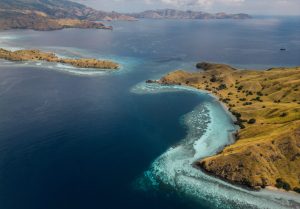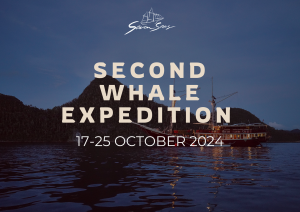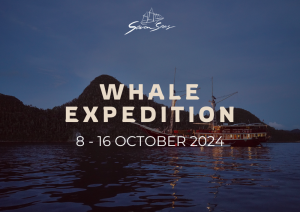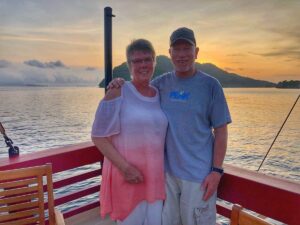By John Tanzer. Photos by Robert Delfs & Tommy Schultz.
Raja Ampat conservation benefits are evident through effective enforcement, ensuring marine biodiversity is protected for future generations. Sitting these last days in a modern, somewhat stark meeting room
Raja Ampat conservation benefits-Sitting these last days in a modern, somewhat stark meeting room in chilly Washington DC seems like another world, in another time, compared to the setting and experiences I have just left. Two weeks previously, my surroundings couldn’t have been more different. I was in the Raja Ampat area of West Papua, Indonesia, cruising and diving this remote and beautiful seascape aboard the charming, fit for purpose vessel the Seven Seas.
Despite the starkly contrasting location and context, the topic on the agenda at the Washington meeting was very relevant to the experiences I had recently had on my trip to Raja Ampat. Gathered in the serious room are some of the leaders of various NGOs and science organizations. The central topic for discussion was how to grapple with the insidious and all too widespread ‘paper parks’ that litter our oceans. Too often declared with much fanfare but often lacking the protection and management to deliver strong outcomes. Also, the ever-controversial topic of whether MPAs (marine protected areas) can actually benefit fisheries sustainability was inevitably bobbing to the surface.
Raja Ampat conservation benefits. As I listened to the discussions range back and forth on what should, or should not, be labelled as a MPA and how governments should be encouraged to identify them by use and level of protection and must implement them, my mind kept drifting back to the wild but fragile beauty and marine resources of Raja Ampat. Most particularly I kept thinking about a number of the dive sites where the diversity, size and numbers of valuable food fish was very high – certainly higher than I had seen in other coral reef areas of the pacific and Indian ocean perhaps outside some of the highly protected areas ‘no take’ areas of the Great Barrier Reef.
Raja Ampat conservation benefits, I promised my daughter I wouldn’t focus on work during the trip and would truly enjoy the experience. Though I tried to avoid ocean management talk on board, it was hard to disconnect completely given my work in marine conservation. Visiting such a diverse marine area naturally blends work, pleasure, mystery, and magic—especially when underwater.
I must admit to being fascinated by fish and their interactions with habitats since I was a boy. Growing up adjacent to the Great Barrier Reef I gravitated towards coral reef fishes and as a keen fisherman it was especially the highly sought-after coral trouts, snappers, cods, wrasses and emperors that I became most interested in. Later, while I was working in the Great Barrier Reef I had a job surveying populations of various coral trouts in different locations. Now whenever I dive on a coral reef I automatically start looking out for these species their numbers, size and behavior – so it was in Raja Ampat Raja Ampat conservation benefits.
I loved dives where we got up close to mantas and sharks but really my best dives were those which were very ‘fishy’. I am pleased to say on this trip there was plenty of those.
One last bit of background, over the last 20 years or so, I have observed and at times been directly involved in, the debate of whether protected areas can contribute to protecting and rebuilding fish populations both within and outside the boundaries. It’s too often been one of those ‘fault line’ issues that serves to distract energy and expertise away from getting on with implementing highly protected areas and instead has needlessly muddied the water around how MPAs should be put in place urgently to protect ecosystem resilience and provide a range of benefits for people – not least off all food but also jobs and livelihoods associated with the large and growing marine tourism industry.
One key of course is to design the location and size of the MPAs well to incorporate the interactions between various habitats, the biology of the associated fish and connectivity (see e.g. coral reef highway). Raja Ampat conservation benefits However just as, if not more, important is to get in place effective enforcement to stop poaching and habitat destruction. Also, somewhat obviously the key to effective management is the level of support and engagement of local communities and stakeholders such as tourism.
Every dive in the Seven Seas is rewarding, with healthy pelagic fish populations. Some locations boast large and abundant fish, such as in protected areas of the Great Barrier Reef. The lack of fishing signs indicates effective protection at some sites.
So after quizzing them it seemed clear to me there was a strong correlation between those sites where I saw really healthy populations of these key demersal reef predators and where strong compliance arrangements were in place. I also asked them about places where I was I was unable to dive – again the same story. Not surprising I guess, but good to see.
Interestingly, strong compliance in many locations is supported by tourism, such as liveaboard boats and eco-resorts that partner with local communities. This protection is maintained through the jobs and livelihoods it generates. I believe these protected areas help boost nearby fish populations, acting as “fish pumps” for open areas.
Meanwhile it is clear these sites and the diverse ecosystems they hold are worth a good deal of money to the local economy. Marine protected areas are most valued where they pay their way. Well protected they will continue to support the resilience of the magnificent reefs of Raja Ampat as well as the wellbeing of communities into the future.
Understanding the Raja Ampat conservation benefits is essential for anyone passionate about marine protection and sustainable travel. As one of the most biodiverse marine regions on Earth, Raja Ampat has become a global example of how conservation can succeed. The Raja Ampat conservation benefits extend beyond protecting coral reefs; they also support local communities, promote eco-tourism, and ensure long-term fishery sustainability. Divers and snorkelers experience firsthand the Raja Ampat conservation benefits through healthier reefs, abundant marine life, and minimal environmental impact. Ongoing research continues to highlight new Raja Ampat conservation benefits, including climate resilience and the preservation of rare species. Whether you’re a visitor or conservation advocate, raising awareness about the Raja Ampat conservation benefits helps strengthen global marine efforts.
John Tanzer,
February 2018
ABOUT JOHN TANZER, WWF OCEANS PRACTICE LEADER
John grew up alongside the Great Barrier Reef in North Queensland, Australia where he developed a deep and lifelong interest in the marine environment. He originally trained in geography and economics and James Cook University. He also holds a Masters degree in environmental law from the Australian National university.
During his career he has worked in both terrestrial and marine environmental management and gained experience in research, field management, strategic policy and organisation management. John`s focus since the mid-nineties has been marine and coastal environments, particularly fisheries and marine protected area management. Of special interest is the role of protected areas in contributing to fisheries sustainability.
He was Chairman and Chief Executive of Queensland Fisheries Management Authority before becoming Executive Director of the Great Barrier Reef Marine Park Authority.
See more about us https://thesevenseas.net/blog/domain-com-raja-ampat-conservation-benefits/
John has served as Director of WWF’s Global Marine Program for the last 5 years, raising the profile of marine conservation around the globe but with a particular focus on tropical coastal areas. His career has been defined by developing partnerships and strong advocacy for community engagement in conservation.
NOTE :
To reserve your spots or see available trips, please check out our schedule page :
Schedule & Availability
Please also don’t hesitate to reach out to us at [email protected] should you require any further information or need recommendations for accommodation or flights etc. Our reservation team would be more than happy to assist. Cheers!





